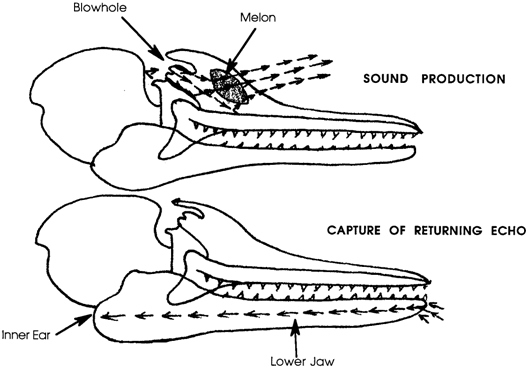by Jessie McGrathKiller Whales
The killer whale is not one of the largest marine species, but it is the largest predatory mammal. The male killer whale is typically larger than the female, with a length 5.8 -6.7 meters and weighing between 1,361 and 3,628 kg. The largest male found was 9.8 meters and weighed 10000 kg. The largest female ever recorded was 8.5 meters and weighed 7,500 kg.
The color of a killer whale is just a plain black and white. But this arrangement of color strengthens their ability to hunt. The black top of the killer whale blends in with the murky depths of the ocean when viewed from above. When viewed from below, the white underside blends in with the tight from above. Their prey has a hard time seeing the whales because of their color contrast against the environment.
The tail of a whale is called a fluke. The fluke has no bones or cartilage so is often curved. The largest fluke size recorded of a killer whale was 2.7 meters long from tip to tip.
Killer whale hearing is very developed, The average hearing range for a human is a low 0.2 to 17 kHz, while the killer whale has a hearing range of 0.5 to 125 kHz. The killer whale’s ears are located just behind the eyes and can receive sound through the soft tissue and bone around the ear, but most of the time they receive sound through their lower jaw. (As shown in the following picture.)

High frequency in the range of 50 kHz and above appears to be received effectively by the lower jaw. The fat filled lower jawbone conducts sound waves through the jawbone into the middle ear, the inner ear and then to the hearing centers in the brain through the auditory nerve.Killer whales also have the ability of echolocation which enables them to locate and discriminate objects by projecting high frequency sound waves and listening for echoes. The sound they project is a high clicking sound. Each click lasts one millisecond. The range of the clicks arc mostly between 10 and 80 kHz. A click range on average is about 26 kHz. The click trains do not come out of their mouths, however, but out of their melon, which is a rounded region on a killer whale’s forehead. The sound waves travel through the water at a speed of about 1.5km/sec (0.9m/see.), which is four-and-one-half times as fast as sound travels through the air. All in all, echolocation allows killer whales to determine the size, shape, speed, distance, direction and even some of the internal structure of objects in the water.
Killer whales have very good eyesight, as well, in and out of the water. A killer whale’s eyes are on each side of the head right above the white “eyespots”. Although many people think their eyes are in those spots, they are actually above them. This is because prey animals may try to injure their eyes in order to escape, but the obvious false eyespot may draw attention away from the real eyes.Killer whales do not have a sense of smell. Being air-breathing animals that spend a majority of their time under water, a sense of smell would go largely unused.
Next to humans, killer whales are the most widely distributed largemammal in the world. Killer whales inhabit all of the oceans in the world. But they are most numerous in the Arctic and other areas of cold water. They are scattered along the shores of Washington, Oregon, California, Baja California, and along the eastern coast of the United States. Although killer whales prefer cold water they also have been sighted in warm water, such as Hawaii, Australia, the Galapagos Islands, the Bahamas, and the Gulf of Mexico. Such sightings are more infrequent but they to do happen. Killer whales have also been seen in fresh water rivers. One even traveled 177 km (110 miles) up the Columbia River to eat fish.
Killer whales mainly migrate by influence of other things. In eastern Canada killer whale movements are often a response to seal and rorqual whale migrations, while the northeastern Atlantic killer whales seem to follow herring. In the Bering, Chukchi and Beaufort seas, killer whales make seasonal migrations in response to the advance and retreat of the ice pack.
Killer whales are not considered an endangered species although their population is unknown. Because of their wide distribution it is very difficult to know the exact number but some specific killer whale populations have been examined. The southeastern population is about 250. The populations around Prince William Sound, western Alaska, the Bering Sea and British Columbia/Puget Sound are believed to be around 300 for each area. Populations in the Antarctic range are estimated at 70,000-180,000.
The killer whale is a very interesting and magnificent animal. I enjoyed learning about them very much and I hope my paper has been educational.